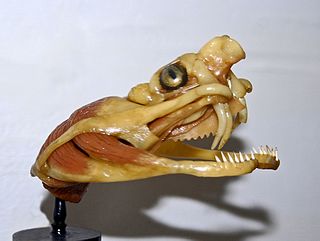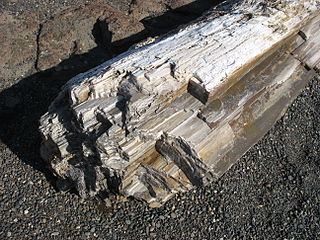Related Research Articles

The Columbia River is the largest river in the Pacific Northwest region of North America. The river rises in the Rocky Mountains of British Columbia, Canada. It flows northwest and then south into the US state of Washington, then turns west to form most of the border between Washington and the state of Oregon before emptying into the Pacific Ocean. The river is 1,243 miles (2,000 km) long, and its largest tributary is the Snake River. Its drainage basin is roughly the size of France and extends into seven US states and a Canadian province. The fourth-largest river in the United States by volume, the Columbia has the greatest flow of any North American river entering the Pacific. The Columbia has the 37th greatest discharge of any river in the world.

Escape from New York is a 1981 American science fiction action film co-written, co-scored and directed by John Carpenter. It stars Kurt Russell, Lee Van Cleef, Donald Pleasence, Ernest Borgnine, Isaac Hayes, Adrienne Barbeau, and Harry Dean Stanton.

Idaho is a state in the Pacific Northwest region of the United States. It borders the state of Montana to the east and northeast, Wyoming to the east, Nevada and Utah to the south, and Washington and Oregon to the west. To the north, it shares a small portion of the Canadian border with the province of British Columbia. With a population of approximately 1.8 million and an area of 83,570 square miles (216,400 km2), Idaho is the 14th largest, the 13th least populous and the 7th least densely populated of the 50 U.S. states. The state's capital and largest city is Boise.

Reptiles, as most commonly defined, are the animals in the class Reptilia, a paraphyletic grouping comprising all amniotes except synapsids and Aves (birds). The class comprises turtles, crocodilians, snakes, amphisbaenians, lizards, tuatara, and their extinct relatives. In the traditional Linnaean classification system, birds are considered a separate class to reptiles. However, crocodilians are more closely related to birds than they are to other living reptiles, and so modern cladistic classification systems include birds within Reptilia, redefining the term as a clade. Other cladistic definitions abandon the term reptile altogether in favor of the clade Sauropsida, which refers to all animals more closely related to modern reptiles than to mammals. The study of the traditional reptile orders, historically combined with that of modern amphibians, is called herpetology.

The Snake River is a major river of the greater Pacific Northwest region in the United States. At 1,078 miles (1,735 km) long, it is the largest tributary of the Columbia River, in turn the largest North American river that empties into the Pacific Ocean. The Snake River rises in western Wyoming, then flows through the Snake River Plain of southern Idaho, the rugged Hells Canyon on the Oregon–Idaho border and the rolling Palouse Hills of Washington, emptying into the Columbia River at the Tri-Cities, Washington.

Snakes are elongated, limbless, carnivorous reptiles of the suborder Serpentes. Like all other squamates, snakes are ectothermic, amniote vertebrates covered in overlapping scales. Many species of snakes have skulls with several more joints than their lizard ancestors, enabling them to swallow prey much larger than their heads with their highly mobile jaws. To accommodate their narrow bodies, snakes' paired organs appear one in front of the other instead of side by side, and most have only one functional lung. Some species retain a pelvic girdle with a pair of vestigial claws on either side of the cloaca. Lizards have evolved elongate bodies without limbs or with greatly reduced limbs about twenty-five times independently via convergent evolution, leading to many lineages of legless lizards. These resemble snakes, but several common groups of legless lizards have eyelids and external ears, which snakes lack, although this rule is not universal.

Hells Canyon is a ten-mile-wide (16 km) canyon in the western United States, located along the border of eastern Oregon, a small section of eastern Washington and western Idaho. It is part of the Hells Canyon National Recreation Area which is also located in part of the Wallowa-Whitman National Forest. It is North America's deepest river gorge at 7,993 feet (2,436 m). Notably, Hells Canyon runs deeper than the better-known Grand Canyon in Arizona.

Squamata is the largest order of reptiles, comprising lizards, snakes, and amphisbaenians, which are collectively known as squamates or scaled reptiles. With over 10,900 species, it is also the second-largest order of extant (living) vertebrates, after the perciform fish. Members of the order are distinguished by their skins, which bear horny scales or shields. They also possess movable quadrate bones, making possible movement of the upper jaw relative to the neurocranium. This is particularly visible in snakes, which are able to open their mouths very wide to accommodate comparatively large prey. Squamata is the most variably sized order of reptiles, ranging from the 16 mm (0.63 in) dwarf gecko to the 5.21 m (17.1 ft) green anaconda and the now-extinct mosasaurs, which reached lengths over 14 m (46 ft).

Solenodons are venomous, nocturnal, burrowing, insectivorous mammals belonging to the family Solenodontidae. The two living solenodon species are the Cuban solenodon, and the Hispaniolan solenodon. Threats to both species include habitat destruction and predation by non-native cats, dogs, and mongooses, introduced by humans to the solenodons' home islands to control snakes and rodents.

The California ground squirrel, also known as the Beechey ground squirrel, is a common and easily observed ground squirrel of the western United States and the Baja California Peninsula; it is common in Oregon and California and its range has relatively recently extended into Washington and northwestern Nevada. Formerly placed in Spermophilus, as Spermophilus beecheyi, it was reclassified in Otospermophilus in 2009, as it became clear that Spermophilus as previously defined was not a natural (monophyletic) group. A full species account was published for this species in 2016.

Rattlesnakes are a group of venomous snakes of the genera Crotalus and Sistrurus of the subfamily Crotalinae. All rattlesnakes are vipers. The scientific name Crotalus is derived from the Greek κρόταλον, meaning "castanet". The name Sistrurus is the Latinized form of the Greek word for "tail rattler" and shares its root with the ancient Egyptian musical instrument the sistrum, a type of rattle. The 36 known species of rattlesnakes have between 65 and 70 subspecies, all native to the Americas, ranging from southern Alberta, Saskatchewan, and southern British Columbia in Canada to central Argentina. The largest rattlesnake, the eastern diamondback, can measure up to 8 ft (2.4 m) in length. Rattlesnakes are predators that live in a wide array of habitats, hunting small animals such as birds and rodents.

Snake venom is a highly toxic saliva containing zootoxins that facilitates in the immobilization and digestion of prey. This also provide defense against threats. Snake venom is injected by unique fangs during a bite, whereas some species are also able to spit venom.

Ginkgo Petrified Forest State Park/Wanapum Recreational Area is a geologic preserve and public recreation area covering 7,124-acre (2,883 ha) on the western shoreline of the Columbia River's Wanapum Reservoir at Vantage, Washington. Petrified wood was discovered in the region in the early 1930s, which led to creation of the state park as a national historic preserve. Over 50 species are found petrified at the site, including ginkgo, sweetgum, redwood, Douglas fir, walnut, spruce, elm, maple, horse chestnut, cottonwood, magnolia, madrone, sassafras, yew, and witch hazel.

The Center for Science in the Public Interest (CSPI) is a Washington, D.C.-based non-profit watchdog and consumer advocacy group that advocates for safer and healthier foods.

Bothriechis schlegelii, known commonly as the eyelash viper, is a species of venomous pit viper in the family Viperidae. The species is native to Central and South America. Small and arboreal, this species is characterized by a wide array of color variations, as well as the superciliary scales above the eyes. It is the most common of the green palm-pitvipers, and is often present in zoological exhibits. The specific name schlegelii honors Hermann Schlegel, who was a German ornithologist and herpetologist. For other common names see below. No subspecies are currently recognized as being valid.
The history of Idaho is an examination of the human history and social activity within the state of Idaho, one of the United States of America located in the Pacific Northwest area near the west coast of the United States and Canada. Other associated areas include southern Alaska, all of British Columbia, Washington, Oregon, western Montana and northern California and Nevada.

Wikipedia is a free content, multilingual online encyclopedia written and maintained by a community of volunteers through a model of open collaboration, using a wiki-based editing system. Individual contributors, also called editors, are known as Wikipedians. It is the largest and most-read reference work in history, and consistently one of the 15 most popular websites ranked by Alexa; as of 2021, Wikipedia was ranked the 13th most popular site. A visitor spends an average time on Wikipedia of 3 minutes and 45 seconds each day. It is hosted by the Wikimedia Foundation, an American non-profit organization funded mainly through small donations.

Lyons Ferry State Park is a public recreation area located near the confluence of the Snake and Palouse rivers, seven miles (11 km) northwest of Starbuck, Washington. The state park is on Route 261 abreast of Lake Herbert G. West, a reservoir on the Snake River created with the construction in the 1960s of the Lower Monumental Dam some 17 miles (27 km) downstream. The park offers facilities for boating, fishing, and swimming. The area is managed cooperatively by the Washington State Parks and Recreation Commission and the U.S. Army Corps of Engineers, which operates the Lyons Ferry Marina.

The House Committee on Un-American Activities (HCUA), popularly dubbed the House Un-American Activities Committee (HUAC), and from 1969 onwards known as the House Committee on Internal Security, was an investigative committee of the United States House of Representatives. The HUAC was created in 1938 to investigate alleged disloyalty and subversive activities on the part of private citizens, public employees, and those organizations suspected of having either fascist or communist ties. When the House abolished the committee in 1975, its functions were transferred to the House Judiciary Committee.
"Of Mist, and Grass, and Sand" is a science fiction short story by Vonda N. McIntyre. First published in Analog Science Fiction and Fact in October 1973, it was anthologized multiple times, and also formed the first chapter of McIntyre's 1978 novel Dreamsnake. Set after a nuclear holocaust, "Of Mist, and Grass, and Sand" tells of Snake, a healer who uses the venom of three genetically engineered snakes to heal, and follows her effort to heal a nomad boy of a tumor. The story won the Nebula Award for Best Novelette in 1974. It was also nominated for the Hugo Award in the same category, and for the Locus Award for Best Short Fiction. Scholar Anne Hudson Jones called it a powerful story, and stated that its themes were "mythic and universal".